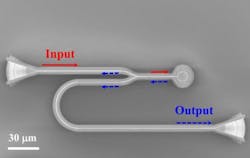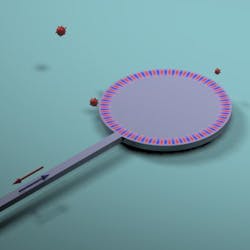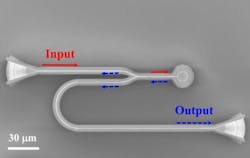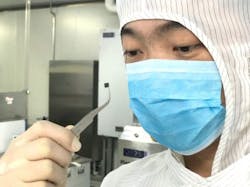Light-delivery approach could improve high-sensitivity biosensors
Recognizing the need to bring down the cost and improve the performance of chip-based biosensors for use at the point of care to detect cancer and other diseases, researchers at the Harbin Institute of Technology (Shenzhen, China) have developed a way to inject light into silicon microdisks. The method could eventually lead to a portable, low-cost optical biosensor for early-stage cancer diagnostics.
Related: Fluorescent biosensor tracks heme compound's activity in cells
Microdisks are a type of microscale resonator that use the whispering-gallery optical effect to confine and enhance light that enters the disk. This allows the microdisk to boost a light-based signal coming from a cell, protein, or virus of interest, allowing more sensitive detection of subtle changes associated with diseases such as lupus, fibromyalgia, and certain heart problems. Research team leader Qinghai Song explains that whispering gallery mode microresonators exist that can be used to resolve single molecules, but their application is limited by problems in device repeatability, stability, and wavelength range. The research team's design, however, works with a variety of wavelengths with low cost, higher stability, and better device repeatability, he claims.
In a paper describing the work, the researchers show that devices using microdisks and end-fire injection can be used to detect temperature changes and the presence of nanoparticles. The team's ultimate goal is to use the technique to create a portable and low-cost sensor that can detect changes in cells that are early indicators of cancer. However, they point out that the new light-coupling configuration could also be useful for integrated photonic circuits for communication applications and a variety of sensors such as those used in homeland security or environmental monitoring.
The researchers' end-fire injection technique uses a waveguide that is directly connected to the edge of the microdisk. Although light that is exactly perpendicular to the disk's side will bounce off the interface, using light angled just slightly less than perpendicular induces a counterintuitive phenomenon known as laser time-reversal. This creates a laser that absorbs light rather than emits it, allowing the light to efficiently enter the microdisk. "Because this configuration doesn’t require any parts that are smaller than 500 nm, it can be fabricated with low-cost techniques," Song says.
To test their design, the researchers fabricated a device that included a microdisk with a 5 µm radius connected to a waveguide. To measure the end-fire injection, they incorporated a Y-splitter that allowed light passing through the splitter to be injected into the microdisk and then be transmitted out of the microdisk along the same waveguide. Recording the spectrum coming from the Y-junction showed that light could be coupled into the microdisk with an efficiency as high as 57%.
They also showed that the device exhibited a high Q factor, a measure of how well the microdisk confines and amplifies the light. In addition, the device maintained good performance parameters even with fabrication deviations such as increasing the waveguide width from 400 to 700 nm.
The researchers also demonstrated that sensors incorporating microdisks and end-fire injection could detect the presence of multiple large nanoparticles as well as single nanoparticles as small as 30 nm. They are interested in using cell-derived vesicles that are around 40 to 100 nm to detect cancer, which should be possible based on their results.
The researchers are now working on other parts of the device that would be needed to use the end-fire injection technique to create a portable and low-cost sensor that can detect early indicators of cancer.
Full details of the work appear in the journal Optica.



